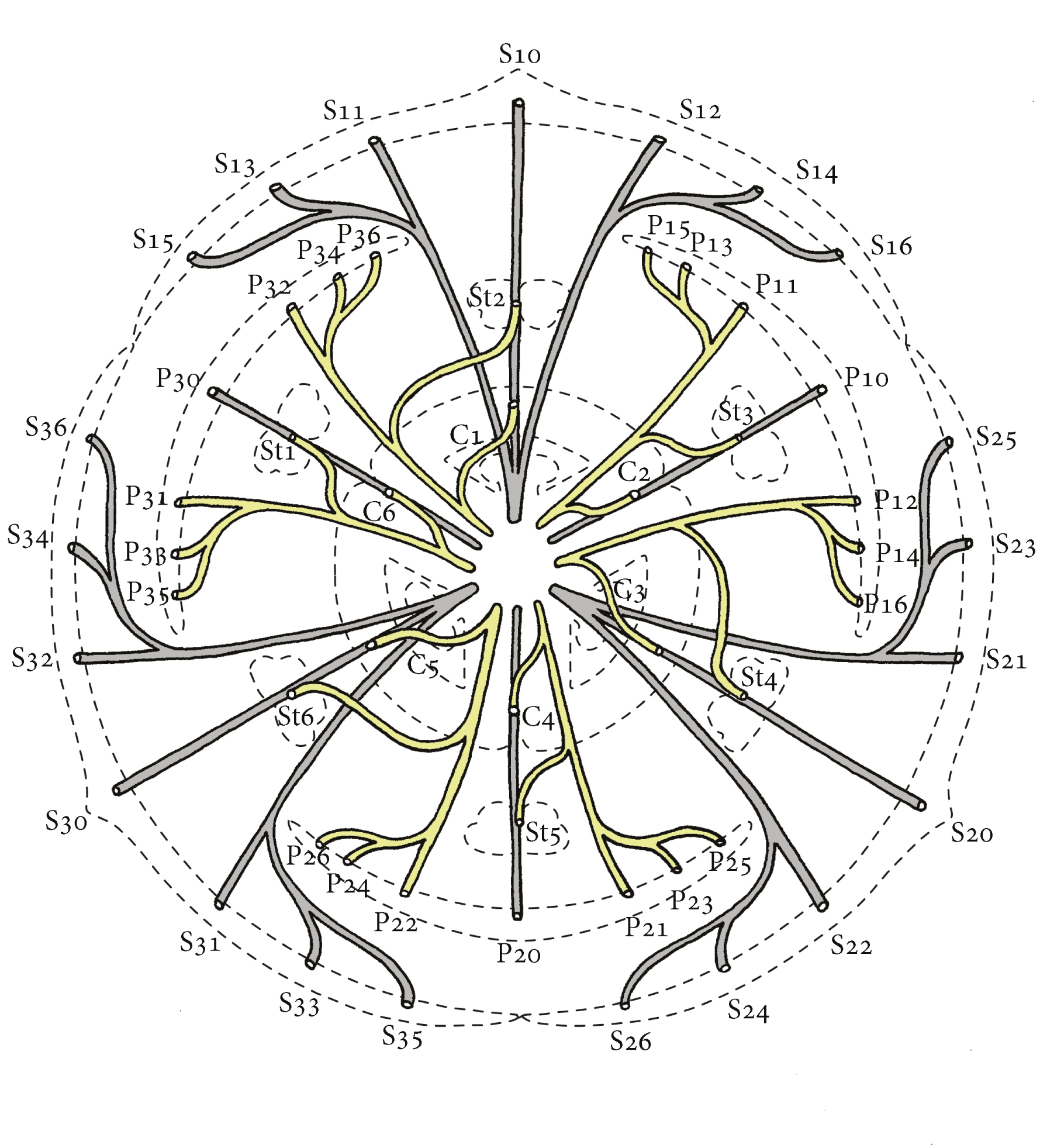Vascular anatomy and morphology of the flower in Fritillaria montana Hoppe (Liliaceae)
Abstract
In the first time structural type of gynoecium and vascular system organization in Fritillaria montana Hoppe flower were described in details. We ascertain that gynoecium is divided in three vertical zones viz synascidiate, symplicate and apocarpous. Therefore the gynoecium was described as syncarpous in wide sense and typified as Fritillaria-type. In the other hand, for the vascular system of the flower six main groups of bundles were described, e.g., recurrent bundles in central column of ovary were observed. It was ascertained that ovules supply by the complex of ventral and dorsal as soon as recurrent bundles. A little difference in the innervation of inner and outer tepals was ascertained too.
References
Bartolucci F., Caparelli K.F., Peruzzi L. 2009. A biometric study of Fritillaria montana Hoppe ex W.D.J. Koch s.l. (Liliaceae) shows a single polymorphic species, with no infraspecific taxa. Plant Biosystems 143 (3): 516–527.
Baum H. 1952. Über die “primitivste” Karpellform. Öst. bot. Z. 99 (5): 632–634.
Bern Convention. 2002. Convention on conservation of European wildlife and natural habitats. Appendix 1 of 1 March 2002: Strictly protected flora species. http://conventions.coe.int/Treaty/FR/Treaties/Html/104-1.htm .
Chorney I.I., Kagalo A.A., Lyubinska L.G. 2009. Fritillaria montana Hoppe. In: Diduh Ya.P. (ed.). Red Book of Ukraine. Plant world: 139. Globalconsulting, Kyiv.
Corneanu G.C. & Popescu G.G. 1981. Distributional and anatomical studies on Fritillaria (Liliaceae) in Romania. Willdenowia 11: 307–315.
Eames A.J. 1961. Morphology of the Angiosperms. McGraw-Hill, NY.
Endress P.K. 2011. Evolutionary diversification of the flowers in Angiosperms. Am. J. Bot. 98 (3): 370–396.
Gerlach D. 1984. Botanische Mikrotechnic. Thieme, Stuttgart.
Guédès M. 1971. Carpel Peltation and Syncarpy in Coriaria ruscifolia L. New Phytol. 70 (1): 213–227.
Hartl D. 1962. Die morphologische Natur und die Verbreitung des Apikalseptums. Analyse einer bisher unbekannten Gestaltungsmoglichkeit des Gynoeceums. Beitr. Biol. Pfl. 37: 241–330.
Igersheim A., Buzgo M., Endress P.K. 2001. Gynoecium diversity and systematics in basal monocots. Bot. J. Linn. Soc. 136: 1–65.
Izmestieva S.V. & Odintsova A.V. 2010. Comparative gynoecium morphology in Stratiotes aloides L. and Hydrocharis morsus-ranae L. (Hydrocharitaceae). Studia Biologica 4 (1): 115–122 (in Ukrainian with English abstract).
Kazemirska M. & Chorney I. 2010a. Fritillaria montana Hoppe (Liliaceae): geografic characteristics, distribution in Ukraine. Biological Systems 2 (3): 63–68 (in Ukrainian with English abstract).
Kazemirska M. & Chorney I. 2010b. Fritillaria montana Hoppe in synanthropiс forest communities in the area between the Prut and the Dniester rivers (Chernivtsi region). Anthropization and Environment of Rural Settlements. Flora and vegetation. 32–33. M.G. Kholodny Institute of Botany, Kyiv.
Kazemirska M. 2011. A short review of history of the research Fritillaria montana Hoppe in Ukraine. Biodiversity. Ecology. Adaptation. Evolution (Proceedings of the V International Young scientists conference, Odessa, June 13–17, 2011): 26-27. Pechatniy dom, Odessa.
Klopfer K. 1969. Zur Ontogenese und Evolution des parakarpen Gynaeceums. Wiss. Z. pädag. Hochsch. Potsdam 13: 207–243.
Leinfellner W. 1950. Der Bauplan des synkarpen Gynözeums. Österr. Bot. Zeitschr. 97 (3–5): 403–436.
Leinfellner W. 1951. Die U-förmige Plazenta als Plazentationstypus der Angiospermen. Öst. bot. Zeitschr. 98: 338–358.
Leins P. 2000. Blüte und Frucht: Aspekte der Morphologie, Entwicklungsgeschichte, Phylogenie, Funktion, Ökologie / Unter Mitarb. von C. Erbar. Schweizerbart, Stuttgart.
Mohammadi-Dehcheshmeh M., Khalighi A., Naderi R., Sardari M., Ebrahimie E. 2008. Petal: a reliable explant for direct bulblet regeneration of endangered wild populations of Fritillaria imperialis L. Acta Physiol. Plant 30: 395–399.
Novikoff A.V. 2008. Floral morphology and vascular anatomy of Ornithogalum caudatum Ait. (Hyacinthaceae). Studia Biologica 2 (1): 87–94 (in Ukrainian with English abstract).
Novikoff A. & Odintsova A. 2008. Some aspects of comparative gynoecium morphology in three brоmelial species. Wulfenia 15: 13–24.
Remizowa M., Sokoloff D., Rudall P.J. 2006. Evolution of the monocot gynoecium: Evidence from comparative morphology and development in Tofieldia, Japonolirion, Petrosavia and Narthecium. Pl. Syst. Evol. 258: 183–209.
Remizowa M., Sokoloff D., Rudall P.J. 2010. Evolutionary History of the Monocot Flower. Ann. Missouri Bot. Gard. 97: 617–645.
Rix E.M. 1974. Notes on Fritillaria (Liliaceae) in the Eastern Mediterranean region, I and II. Kew Bulletin 29 (4): 633–654.
Rix E.M. 1975. Notes on Fritillaria (Liliaceae) in the Eastern Mediterranean Region, III. Kew Bulletin 30 (1): 153–162.
Rix E.M. 1979. Notes on Fritillaria (Liliaceae) in the Eastern Mediterranean Region, IV. Kew Bulletin 33 (4): 585–600.
Rix E.M. 1980. Fritillaria L. In: Tutin T.G., Heywood V.H., Burges N.A., Valentine D.H., Walters S.M. and Webb D.A. (eds). Flora Europaea. Vol. 5: 31–34. Cambridge Univ. Press, Cambridge.
Ronse De Craene L.P., Soltis P.S., Soltis D.E. 2003. Evolution of floral structures in basal angiosperms. Int. J. Pl. Sci. 164: 329–363.
Sterling C. 1973. Comparative morphology of the carpel in the Liliaceae: Colchiceae (Adrocymbium). Bot. J. Linn. Soc. 67: 149–156.
Takhtajian A.L. 1942. The structural types of gynoecium and the placentation. Bulletin of the Armenian branch of the Academy of Sciences of the USSR 3–4 (17–18): 91–112 (in Russian with English abstract).
Takhtajian A.L. 1964. The basics of evolutionary morphology of Angiosperms. Science, Moscow–Leningrad. In Russian.
Troll W. 1932. Morfologie der Schildförmigen Blätter. Planta 17: 153–314.
van Heel W.A. 1988. On the development of some gynoecia with septal nectaries. Blumea 33: 477–504.
Zaharof E. 1988. A phenetic study of Fritillaria (Liliaceae) in Greece. Pl. Syst. Evol. 161: 23–34.


This work is licensed under a Creative Commons Attribution-NonCommercial-NoDerivatives 4.0 International License.
The journal is licensed by Creative Commons under BY-NC-ND license. You are welcome and free to share (copy and redistribute the material in any medium or format) all the published materials. You may not use the material for commercial purposes. You must give appropriate credit to all published materials.
The journal allow the author(s) to hold the copyrights and to retain publishing rights without any restrictions. This is also indicated at the bottom of each article.





